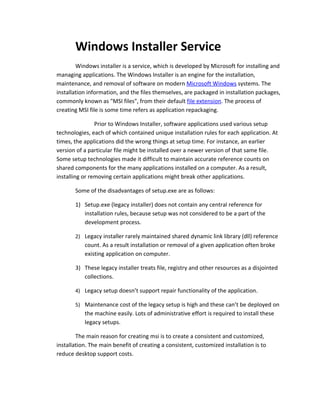Windows Installer Service
•Download as DOC, PDF•
1 like•215 views
Advantage of Windows Installer service.
Report
Share
Report
Share

Recommended
Recommended
More Related Content
Featured
Featured (20)
Product Design Trends in 2024 | Teenage Engineerings

Product Design Trends in 2024 | Teenage Engineerings
How Race, Age and Gender Shape Attitudes Towards Mental Health

How Race, Age and Gender Shape Attitudes Towards Mental Health
AI Trends in Creative Operations 2024 by Artwork Flow.pdf

AI Trends in Creative Operations 2024 by Artwork Flow.pdf
Content Methodology: A Best Practices Report (Webinar)

Content Methodology: A Best Practices Report (Webinar)
How to Prepare For a Successful Job Search for 2024

How to Prepare For a Successful Job Search for 2024
Social Media Marketing Trends 2024 // The Global Indie Insights

Social Media Marketing Trends 2024 // The Global Indie Insights
Trends In Paid Search: Navigating The Digital Landscape In 2024

Trends In Paid Search: Navigating The Digital Landscape In 2024
5 Public speaking tips from TED - Visualized summary

5 Public speaking tips from TED - Visualized summary
Google's Just Not That Into You: Understanding Core Updates & Search Intent

Google's Just Not That Into You: Understanding Core Updates & Search Intent
The six step guide to practical project management

The six step guide to practical project management
Beginners Guide to TikTok for Search - Rachel Pearson - We are Tilt __ Bright...

Beginners Guide to TikTok for Search - Rachel Pearson - We are Tilt __ Bright...
Windows Installer Service
- 1. Windows Installer Service Windows installer is a service, which is developed by Microsoft for installing and managing applications. The Windows Installer is an engine for the installation, maintenance, and removal of software on modern Microsoft Windows systems. The installation information, and the files themselves, are packaged in installation packages, commonly known as "MSI files", from their default file extension. The process of creating MSI file is some time refers as application repackaging. Prior to Windows Installer, software applications used various setup technologies, each of which contained unique installation rules for each application. At times, the applications did the wrong things at setup time. For instance, an earlier version of a particular file might be installed over a newer version of that same file. Some setup technologies made it difficult to maintain accurate reference counts on shared components for the many applications installed on a computer. As a result, installing or removing certain applications might break other applications. Some of the disadvantages of setup.exe are as follows: 1) Setup.exe (legacy installer) does not contain any central reference for installation rules, because setup was not considered to be a part of the development process. 2) Legacy installer rarely maintained shared dynamic link library (dll) reference count. As a result installation or removal of a given application often broke existing application on computer. 3) These legacy installer treats file, registry and other resources as a disjointed collections. 4) Legacy setup doesn’t support repair functionality of the application. 5) Maintenance cost of the legacy setup is high and these can’t be deployed on the machine easily. Lots of administrative effort is required to install these legacy setups. The main reason for creating msi is to create a consistent and customized, installation. The main benefit of creating a consistent, customized installation is to reduce desktop support costs.
- 2. Repackaging of an application to msi seeks to eliminate these types of issues through “customized consistency”. Customized consistency means customizing, or repackaging, an installation so that it behaves in a manner consistent with the company’s standards. Adherence to standards means that end user desktops are easier to support because the system administrator knows the software installed on them conforms to predefined standards that, in turn, reduce support costs. Some advantages of creating MSI are: 1) This technology creates reliable packages that can be successfully distributed through an organization through SMS server (System management Server). 2) Provide consistent and reliable version rules. 3) Provide Advertisement: The installer registers the application, creates shortcuts and menu entries, associates file types etc. without actually copying the application files to the user's hard drive. If the user or another application tries to access the advertised program, it is installed on demand. In this case, the invoking of the installer is handled by the operating system. 4) Provides installation on Demand: This is quite similar to Advertising. However, it doesn't refer to a whole application, but to a feature or function that is called from inside the application. When the application tries to access the feature and finds that it isn't present, it calls the installer service to install it just in time. These way users don’t have to anticipate the functionality they need before they ever used the product. 5) Rollback: The installer records all changes it makes to the system, and creates temporary backup copies of overwritten and removed files. If setup is aborted, the system is reverted to its previous state. After the setup is finished successfully, the rollback information and backup files are deleted to save disk space.